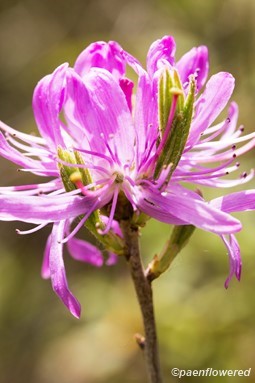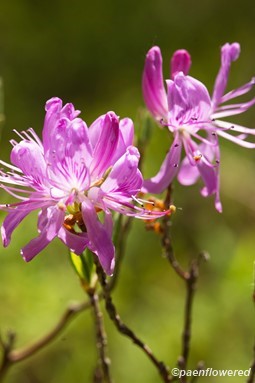Rhododendron canadense
Rhododendron canadense rhodora
Canada rosebay, also known as rhodora, is a deciduous flowering shrub native to northeastern North America. The plant is celebrated for its delicate yet striking beauty. Its pinkish-purple flowers, which bloom in mid to late spring before the leaves emerge, create a breathtaking contrast against the muted tones of bogs and woodlands. The petals are lobed and slightly fringed, giving the flowers a soft, airy appearance. It reaches a height of 1-3 feet. The plant’s ability to thrive in wet, acidic soils and its resilience in harsh climates add to its mystique.
In literature, rhodora’s beauty was immortalized by Ralph Waldo Emerson in his poem The Rhodora, where he admired its quiet elegance in the wild. It is also the namesake of the New England Botanical Society’s journal, "Rhodora", which has been published since 1899.
Habitat & Range
Rare but often locally abundant in bogs, peaty wetlands and barrens in moist acidic soils. Can also adapt to drier environments.
Present mostly in the north-east of the state. See distribution map at BONAP.
Range: Northeastern North America, including Pennsylvania, New England, New York, New Jersey, and extends into Newfoundland, Quebec and Ontario.
| EMP: | FACW |
|---|---|
| NCNE: | FACW |
Phenology
Flowers mid to late May, before the leaves.
Fruits late summer to early fall.
Characteristics
Flowers bisexual, 10 stamens; corolla rose-purple with 2 long flaring lobes (lower lip) and 3 short lobes (upper lip)
Leaves simple, alternate, revolute, elliptic to oblong; gray-green or bluish-green; margins entire, drop off in the winter; often glaucous; pubescent below
Bark thin, smooth, reddish-brown that starts to peel off esily with age, contributing to shrub's ragged appearance
Buds scaled, overlapping
Twigs reddish-brown, covered with fine hairs when young turning smooth and thicker when mature; often glaucous
Fruit dry, 5-parted capsule assymetrical at the base and hump-backed; often glaucous; splits open when ripe; tiny seeds dispered by wind in the fall
Height 1 to 3 feet
Age 30 to 50 yrs
Fall Color yellow-green to reddish-purple
Plant Codes
S-rank: No Rank
G-rank: G5 (Secure)
Ecology
Bees and bumblebees are the primary pollinators. Also, the plant provides nectar for butterflies, bees and flies, including the bog elfin butterfly and Columbia silkmoth.
Mostly deer-resistant.








Comments
Have you spotted this plant in your area? We'd love to hear about your experience! Share your comments or questions about the plant below. Comments are moderated before posting.